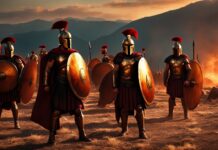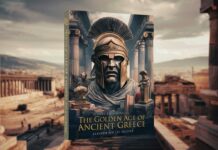Picture a young boy standing on the slopes of Mt. Taygetus, watching Spartan warriors march. The morning sun casts long shadows, showing their unity. This scene shows the heart of Sparta: a place where strength and bravery were key.
From its start, linked to Heracles, to becoming a top military force around 650 BC, Sparta’s story is fascinating. The Spartans were known for their strength and bravery.
As the boy gets older, he learns about the famous battle of Thermopylae. King Leonidas and 300 Spartans fought bravely against a huge Persian army. This battle showed their strength and courage.
But Sparta was more than just about war. It had a unique social system thanks to Lycurgus. The Spartans went through tough training called the Agoge. This made them some of the best fighters in the world.
But Sparta’s story isn’t just about winning. After losing to Thebes in 371 BC, it joined the Achaean League in 192 BC. This shows the complex legacy of Sparta, which has influenced Western culture.
The rise and fall of Sparta, along with its unique society, invites us to explore its lasting impact. We honor the legacy of this ancient civilization.
Introduction
This eBook aims to give a deep look into the world of Spartans. It covers their complex history and how they lived. We’ll explore their military strength, how they governed, and their everyday life. This will help us understand ancient Greek culture better.
Purpose of the eBook
The main goal of this eBook is to show why Sparta was important in ancient times. We’ll look at its early days, military victories, and how these shaped Spartan society. It’s a key guide for those wanting to learn about Spartan culture.
Brief overview of Spartan significance in history
Sparta’s role in history is huge. It was known for its strict social rules and strong military. Spartan warriors were key in the Peloponnesian War, winning against other cities.
Structure of the eBook
This eBook takes you through different parts of Spartan history. We’ll cover their beginnings, myths, society setup, education, and military tactics. We’ll also look at women’s roles and how Sparta declined. This gives a full picture of their story.
Chapter 1: Early Origins of Sparta
The early story of Sparta is full of myth and geography. This chapter shows how Greek myths tell us about Sparta’s start. It talks about the legendary king Lacedaemon, who gave the area its name. This mix of legend and history helps us understand Sparta’s growth into a powerful city-state.
Mythological Beginnings
Legend says that Sparta started with Lacedaemon and his wife, Sparta. Together, they had the city, linking divine favor with national identity. This story helped create a strong Spartan culture. It taught the importance of strength, honor, and discipline for everyone.
Geographical and Cultural Context
Sparta’s location is key to its story. It sits in the Eurotas valley in southeastern Peloponnese. The area’s mountains and the Eurotas River made it a strategic spot. This helped create a culture where being strong in battle was crucial.
With lots of land and resources, the Spartans built a society focused on agriculture. This gave them a strong economy. It supported their famous military system.
Chapter 2: The Spartan Society and Government

The governance in Sparta shows a complex social setup. It had different groups like Spartiates, Helots, and Perioeci. Each group had its own role, making the society strong and focused on the military.
The Spartan Social Structure
The social setup in Sparta was all about military strength and discipline. Spartiates were the top citizens, known for their tough military training starting at age seven. They held the power and were the only full citizens.
Helots were the enslaved people who worked in agriculture and supported the economy. Perioeci were free but not citizens, living outside Sparta and working in trade and crafts. They helped the economy but couldn’t vote.
Government and Political System
Sparta’s government was unique, with two kings ruling together. This system kept the government stable and balanced. The Gerousia, a council of elder citizens, advised the kings and made laws.
This mixed system combined monarchy, oligarchy, and democracy. It showed how Sparta’s focus on military strength helped it become a leading power in ancient Greece.
Chapter 3: The Agoge and Spartan Education

The Agoge system was key to Spartan education. It was designed to make disciplined and skilled warriors from a young age. Boys started this tough training at seven and stayed until they were about thirty. They learned military skills and how to be physically strong.
This education taught them more than just how to fight. It also made them deeply loyal to their community and the state.
The Agoge System
All Spartan males had to go through the Agoge. It was a program that moved boys from a nurturing family life to a strict military life. Boys aged seven to twelve learned basic reading and got ready for physical challenges.
They also learned important survival skills. If they stole, they faced a harsh punishment. This taught them the value of being smart and tough.
Role of Family and Community
Once boys joined the Agoge, their family roles changed. Fathers played a big part in their early years, but the state took over as they entered the Agoge. This made a strong community feeling as boys trained together.
They went through tough inspections and sports that tested their limits. Girls in Sparta didn’t go through the Agoge. They stayed home and learned the values that made a Spartan.
This way, every Spartan male became a soldier and a full member of society. They were ready to defend their city’s values.
Chapter 4: Military Excellence

The Spartan military is famous for its tough training and discipline. It’s known as one of the strongest forces in ancient times. This strength comes from the way the army was set up, with hoplites at its core.
Hoplites were heavily armed foot soldiers. They fought in a tight formation called a phalanx. This tactic was key in many famous battles across the ancient world.
The Spartan Army
From age seven, Spartiates started their military training. They went through the Agoge system, focusing on fitness, fighting skills, and staying power. This tough training got them ready for a life in the military.
By twenty, they became full citizens and joined syssitia, building strong military bonds. Over time, Spartan military strategy changed to meet new challenges in battles.
Famous Battles and Campaigns
The Spartan military’s achievements are well-known, especially in the Peloponnesian War and the Battle of Thermopylae. At Thermopylae, 300 Spartans, led by King Leonidas, showed incredible bravery against a huge Persian army.
This battle showed Spartan bravery and tactical skill. It also showed their deep commitment to their way of life. The impact of these battles still echoes today, highlighting Spartan military excellence and civic virtue in war.
Chapter 5: Daily Life in Sparta

The daily life in Sparta was deeply connected to its unique economy and cultural ways. This chapter looks at the farming roots of Spartan society and the customs that brought people together.
Economic System
The Spartan economy was built on farming, thanks to fertile land. The Helots, a lower class, worked hard in the fields. This let Spartan citizens train for war. Landowners enjoyed the crops without doing the hard work themselves.
This economy was simple, aiming for equality among citizens. It didn’t encourage building up wealth.
Cultural Practices
Spartan culture was all about sports, religious events, and coming together as a community. Being strong was a big part of life, shown in the Olympic Games. Public events celebrated their military strength and brought people closer together.
These activities taught values like discipline, endurance, and loyalty to the state. They made a society ready for challenges and strong in spirit.
Chapter 6: Spartan Women
In Sparta, women had a special place unlike other Greek cities. They had more freedom and rights than women in other places. They played a big role in society, handling family money, businesses, and estates while men were away at war.
This gave Spartan women a freedom not often seen in Ancient Greece. They were educated, fit, and could own land and property. This was different from Athenian women, who had many limits on their lives.
Aristotle talked about this freedom, saying it might have led to Sparta’s decline. But, being fit and active was key to their lives. It made them important to Spartan society.
Role and Status
Spartan women were more free than women in other areas. They could own land and inherit property, which was rare for women in Ancient Greece. This made some Spartan women very influential.
They were educated and fit, unlike many women of their time. Aristotle thought this freedom might have hurt Sparta, but it made Spartan women vital to their society.
Notable Spartan Women
Many famous Spartan women stood out for their strength and resilience. They took part in sports and cultural events, showing their skills. Spartan girls were trained just like boys, making them strong and skilled.
They also had relationships with other women, which helped them become wealthy and respected. This allowed them to manage their families and play a big role in Sparta’s economy.
Chapter 7: The Decline of Sparta
The decline of Sparta was a key event in ancient Greek history. It was caused by internal problems and military losses. Sparta was once a top city-state but faced challenges that took away its power and status.
Internal Struggles and Reforms
Inside Sparta, there were big internal issues that led to reforms. The strict social setup and the use of helots caused problems. Helots made up a big part of the population but were slaves.
This situation made it hard for Sparta to have a strong political plan. Only 15% of citizens were in charge, which made it hard to look after everyone’s needs. Even though Sparta was known for its strong military, it couldn’t come up with new ideas to fix its problems.
Military Defeats and Loss of Dominance
Military losses were a big part of Sparta’s decline. The loss at the Battle of Leuctra showed that Sparta wasn’t unbeatable. As Sparta started losing battles against other Greek city-states, its power in the region went down.
Even though Sparta was a big name in the classical period, it found it hard to make political gains. This showed that its influence was fading.
Sparta’s Legacy and Influence
Even though Sparta declined, its impact is still felt today. It’s known for its strict military and social structure. Critics say it was too rigid and used a harsh system with helots.
Yet, Sparta’s legacy still shapes how we think about leadership and military tactics. The lessons from its struggles and defeats teach us about the dangers of power and the weaknesses in any society.
Chapter 8: Legacy and Influence of Sparta
Sparta’s legacy is deeply rooted in Western history and thought. Its military strength, social structure, and philosophical ideas have left a lasting impact. These ideas influence modern views on governance and military strategy.
People admire and criticize Sparta for its approach to power, education, and discipline. This shows how Sparta’s systems affect us today.
Historical Impact
Starting in the 8th Century BCE, Sparta turned Messenia into a land of Helots, a class of serfs. This helped secure Spartan agriculture and created a society of oppression and inequality. Spartan culture focused on tough education through the agoge system, training boys for military from a young age.
The society was divided into three classes: Spartiates, Perioikoi, and Helots, each with their roles and rights. Politically, Sparta had a unique system with dual kings and a council of thirty, but the Ephors had a lot of power. Aristotle questioned the true nature of Spartan society, suggesting its efficiency might hide deeper issues.
The Krypteia, a secret police force, shows how Sparta kept control by frightening the Helots.
Modern Perceptions
Modern stories often romanticize Spartan culture, like in “300” by Frank Miller. These stories make Sparta seem like an ideal warrior society. But they might not show the full picture, including women’s roles and governance issues.
Spartan women had more freedom than many today, managing their homes and being physically active. This is a big difference from many societies now.
Today, we talk about Sparta’s legacy with both praise and criticism. These discussions give us deep insights into what made Spartans who they were and their lasting impact on military and political thought. As we keep learning about Sparta, we’re having a deeper conversation about power, society, and human nature.
Conclusion
This journey through Sparta’s history highlights key points. Sparta was known for its strong military, smart strategies, and unique way of life. These factors greatly shaped its lasting impact.
The Agoge system taught discipline early on. Spartans won big battles like Thermopylae and Plataea. This shows how important Sparta is for learning about ancient military and social systems.
Spartans lived simply and shared everything in common. This way of life sparked deep thoughts on society. Even though the elite few in Sparta had less power, their values still shape our ideas on leadership and community today.
The future of studying Sparta is bright with many possibilities. Scholars can look into why Spartans lost battles like Leuctra. This could add more to our understanding of Greek history.
Studying Sparta helps us see its role in the broader Mediterranean world. The lessons from Sparta’s history are still useful today. This keeps scholars interested in Sparta’s ongoing importance.
Appendices
The appendices are key for those wanting to learn more about Spartan history. They have a glossary of terms that explain important parts of Spartan society, culture, and military ways. This glossary makes it easier for readers to understand the article’s information.
Glossary of Terms
This section has a detailed glossary of important terms about Sparta. Knowing these terms helps readers get the full picture of Spartan life. It covers everything from civic duties to military values, making the reading more engaging.
Chronology of Major Events
The chronology of major events lists the key moments in Spartan history. It includes the famous battle at Thermopylae and the decline after 371 B.C. This timeline helps readers see how Sparta rose and fell in Greek history. It makes the historical story clear.
Bibliography and Further Reading
There’s a big list of books and resources for those wanting to learn more about Spartans. Works like Thucydides’ stories give deep insights into the conflicts between Sparta and Athens. This list is great for both academic and personal study of Spartan themes.
Index
The index is a helpful guide that lets readers find specific topics and terms easily. It makes finding information quick and easy, improving how readers connect with the content.




















